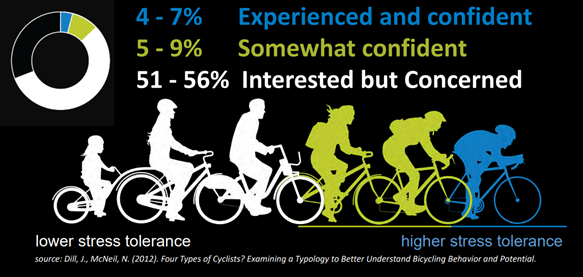This content was originally published by the Longmont Observer and is licensed under a Creative Commons license.
Bicyclists and drivers in Longmont may notice some new changes to the bike lanes and roads in select parts of southern Longmont.
Dubbed the bike lane trial project (BLTP), the City of Longmont launched the project this week on Wednesday, June 27th as an effort to "improve and expand" the city's current "bicycle network".
The project, which is guided by the city’s Envision Longmont Multimodal & Comprehensive Plan, will last for one year and is estimated to cost $50,000. The funds will be paid for via Longmont's street fund; they were appropriated in the 2018 budget.
The goals of the project are to "allow bicycle users of different abilities to explore what bike lane treatments they prefer, test treatments in the field for bicyclists, drivers and city maintenance crews, and collect feedback from residents about their experiences traveling in the test areas," wrote Holly Milne, Longmont's Communications and Marketing Manager for the Public Works & Natural Resources department, in an email to the Longmont Observer.
Bicyclists and drivers will notice three different types of so-called "on-street bicycle facilities": a shared lane arrow/sharrows on S. Bowen Street between Iowa Avenue and S. Pratt Parkway, a buffered bike lane on S. Pratt Parkway between Ken Pratt Boulevard and Pike Road, and a separated bike lane on Pike Road (westbound only) between S. Sunset Street and S. Hover Street.
According to city council communication:
The “sharrows” or shared street is appropriate for low-volume, low-speed streets where bicyclists can share the travel lane with vehicular traffic," according to city council communication.Buffered bike lanes are conventional bicycle lanes paired with additional street striping that creates designated buffer space separating the bicycle lane from the adjacent motor vehicle travel lane and/or parking lane.
Separated bike lanes use a combination of horizontal separation (like buffer distance) and vertical separation (such as flexible posts, curbs and/or parked cars) to protect bicyclists from motor vehicle traffic. The combination of separation elements can provide a lower stress bicycle experience as compared to a shared or conventional bike lane. This treatment is best suited for high-volume, high-speed roads.
The City of Longmont chose these streets because "each street segment and the treatment identified for it had to fit feasibility criteria. Retrofitting bicycle facilities into existing streets requires evaluating space available, traffic travel speeds, maintenance operations (e.g. snow removal, street sweeping, etc.) and connectivity to the greater Longmont bicycle network," wrote Milne.
When asked if the City of Longmont knows, on average, how many people utilize the bike lanes, Milne stated that the city has limited bicycle count information (i.e. peak hour) at major intersections as they do not have reliable data along the corridors.
"The challenge we face is how to accurately collect bicycle data since the peak bicycle usage times tend to occur during the middle of the day or on the weekends, and doesn’t match up very well with other data collection efforts," wrote Milne.
"In addition, the traffic tubes that are used to collect 24-hour vehicle traffic counts and speed data do not do a good job of measuring bicycles. Further, the tubes would only go across the road and would not capture bicyclists who may be riding on the sidewalk. We believe that some of the trial bicycle treatments will appeal to a larger cross-section of bicyclists, including those who previously wouldn’t feel comfortable riding on the street."
In addition to collecting feedback throughout the year, the City of Longmont will also be looking at how the BLTP impacts street maintenance.
"We’ll be evaluating how these facilities impact street maintenance activities like snow plowing and street sweeping, as well as the general durability of the facilities installed (especially for devices used to create protected bike lanes)," wrote Milne.
When asked how the BLTP will be deemed a "success", Micah Zogorski, Senior Civil Engineer for the City of Longmont, wrote that the "city is testing new bicycle treatments that have not yet been used in Longmont to determine if they appeal to a larger cross-section of bicyclists who otherwise would be hesitant to use the on-street bike lanes."
"A majority of bicycle riders (“Interested but Concerned” category) prefer a lower stress environment, see exhibit below, so we are evaluating the different types of treatments to determine which ones make bicyclists feel safe and likely to ride on the street. Another important outcome of the trial project will be the feedback from the bicyclists, motorists and especially our maintenance staff, so we can better understand the operational challenges with the separated bike lane treatment."

"The city continues to evaluate and look for opportunities to improve our transportation system for all modes of travel, including bicycling. The various types of treatments being evaluated with the Bike Lane Trial Project could be used at other locations throughout the City," wrote Zogorski.


